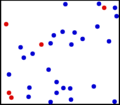Elastic collision facts for kids
An elastic collision is when two objects hit each other and bounce off. In this type of collision, the objects don't get squished or bent permanently. Think of two super bouncy rubber balls colliding; they bounce back almost perfectly. This is different from, say, two cars crashing, where the cars get crumpled and don't bounce back. That's called an inelastic collision.
In a perfect elastic collision, no kinetic energy is lost. Kinetic energy is the energy an object has because it's moving. So, the total kinetic energy of the objects after they hit is the same as their total kinetic energy before they hit. This means no energy turns into other forms like heat or sound.
Another important rule for elastic collisions is that momentum is conserved. Momentum is a measure of how much "oomph" an object has when it's moving. It depends on an object's mass and how fast it's going. When objects collide elastically, their total momentum before the collision is the same as their total momentum after the collision.
Contents
Understanding Elastic Collisions
To understand elastic collisions better, we often look at two main rules: the conservation of momentum and the conservation of kinetic energy. These rules help us figure out what happens to objects after they collide.
Momentum Stays the Same
Imagine two objects, like two balls, about to collide. Each ball has a certain mass and is moving at a certain speed. We can calculate its momentum.
- Momentum is found by multiplying an object's mass by its velocity (speed in a certain direction).
- Before the collision, we add up the momentum of both balls.
- After the collision, we add up their new momentum.
- For an elastic collision, these two totals must be equal! The total momentum of the system doesn't change.
Kinetic Energy Stays the Same
Just like momentum, the total kinetic energy of the objects also stays the same in a perfect elastic collision.
- Kinetic energy depends on an object's mass and the square of its velocity.
- Before the collision, we calculate the kinetic energy of each ball and add them up.
- After the collision, we do the same with their new velocities.
- In an elastic collision, the total kinetic energy before and after the collision is exactly the same. No energy is lost as heat, sound, or deformation.
Solving a Collision Problem
Let's look at an example to see how these rules work. Imagine two balls colliding:
- Ball 1: weighs 3 kg, moving at 4 meters per second (m/s).
- Ball 2: weighs 5 kg, moving at -6 m/s (the negative sign means it's moving in the opposite direction).
After they collide, we know:
- Ball 1: is now moving at -8.5 m/s.
- Ball 2: its speed is unknown. Let's call it 'v'.
We can use the rule of conservation of momentum to find the unknown speed of Ball 2. The total momentum before the collision must equal the total momentum after.
- Momentum before: (3 kg * 4 m/s) + (5 kg * -6 m/s) = 12 - 30 = -18 kg·m/s
- Momentum after: (3 kg * -8.5 m/s) + (5 kg * v) = -25.5 + 5v
Setting them equal: -18 = -25.5 + 5v Add 25.5 to both sides: 7.5 = 5v Divide by 5: v = 1.5 m/s
So, Ball 2 is moving at 1.5 m/s in the positive direction after the collision.
We could also use the conservation of kinetic energy to solve this, but it often involves more complex math, especially with square roots, and might not tell us the direction of motion directly. The momentum rule is usually simpler for finding velocities.
Images for kids
-
As long as black-body radiation (not shown) doesn't escape a system, atoms in thermal agitation undergo essentially elastic collisions. On average, two atoms rebound from each other with the same kinetic energy as before a collision. Five atoms are colored red so their paths of motion are easier to see.
See also
 In Spanish: Choque elástico para niños
In Spanish: Choque elástico para niños



